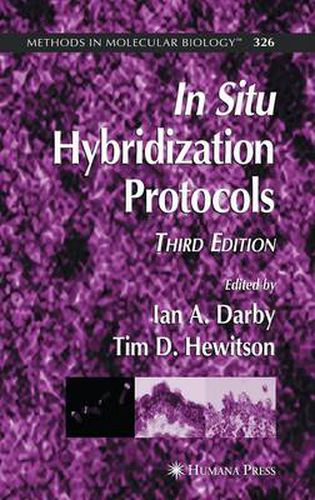Readings Newsletter
Become a Readings Member to make your shopping experience even easier.
Sign in or sign up for free!
You’re not far away from qualifying for FREE standard shipping within Australia
You’ve qualified for FREE standard shipping within Australia
The cart is loading…






This title is printed to order. This book may have been self-published. If so, we cannot guarantee the quality of the content. In the main most books will have gone through the editing process however some may not. We therefore suggest that you be aware of this before ordering this book. If in doubt check either the author or publisher’s details as we are unable to accept any returns unless they are faulty. Please contact us if you have any questions.
The technique of in situ hybridization, in its various forms, has been used routinely in many laboratories for a number of years. In the post-genome era, gene arrays and proteomics have allowed us to identify hitherto unknown unrecognized pathways and mechanisms. However, rather than diminish the importance of in situ hybridization, the now widespread use of screening te- nologies has increased the need to temporally and spatially localize the dist- bution of mRNA expression. Our intention, in In Situ Hybridization Protocols is to provide ample inf- mation for novices planning to set up the in situ hybridization technique and use it in their laboratory for the first time, as well as giving updates of recent developments for those laboratories where in situ hybridization techniques are already in use. Despite its widespread significance, in situ hybridization has retained a re- tation as one of the more difficult and capricious molecular biological te- niques. This may in part be because of the hybrid nature of the technique, which often requires a mixture of molecular biological and histological skills. The two techniques are usually taught and acquired in different streams of biolo- cal science. The step-by-step and detailed protocols provided in In Situ Hybridization Protocols by researchers active in the field should make it p- sible for both the molecular biologist with little experience of histology and the histologist with little experience of molecular biology to use the technique s- cessfully in their laboratories.
$9.00 standard shipping within Australia
FREE standard shipping within Australia for orders over $100.00
Express & International shipping calculated at checkout
This title is printed to order. This book may have been self-published. If so, we cannot guarantee the quality of the content. In the main most books will have gone through the editing process however some may not. We therefore suggest that you be aware of this before ordering this book. If in doubt check either the author or publisher’s details as we are unable to accept any returns unless they are faulty. Please contact us if you have any questions.
The technique of in situ hybridization, in its various forms, has been used routinely in many laboratories for a number of years. In the post-genome era, gene arrays and proteomics have allowed us to identify hitherto unknown unrecognized pathways and mechanisms. However, rather than diminish the importance of in situ hybridization, the now widespread use of screening te- nologies has increased the need to temporally and spatially localize the dist- bution of mRNA expression. Our intention, in In Situ Hybridization Protocols is to provide ample inf- mation for novices planning to set up the in situ hybridization technique and use it in their laboratory for the first time, as well as giving updates of recent developments for those laboratories where in situ hybridization techniques are already in use. Despite its widespread significance, in situ hybridization has retained a re- tation as one of the more difficult and capricious molecular biological te- niques. This may in part be because of the hybrid nature of the technique, which often requires a mixture of molecular biological and histological skills. The two techniques are usually taught and acquired in different streams of biolo- cal science. The step-by-step and detailed protocols provided in In Situ Hybridization Protocols by researchers active in the field should make it p- sible for both the molecular biologist with little experience of histology and the histologist with little experience of molecular biology to use the technique s- cessfully in their laboratories.